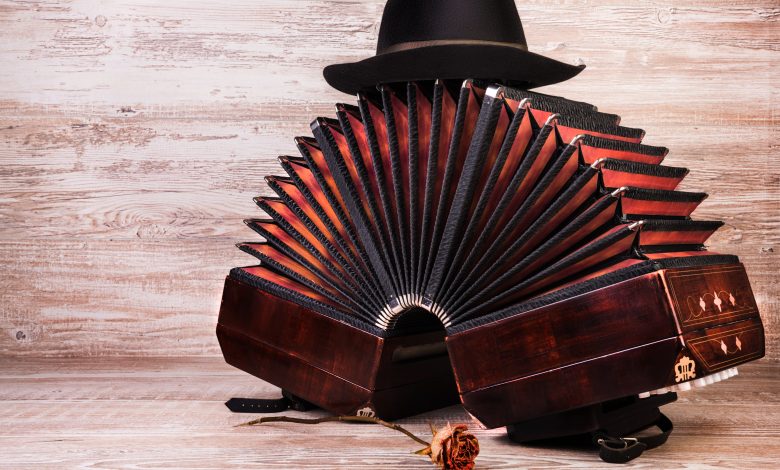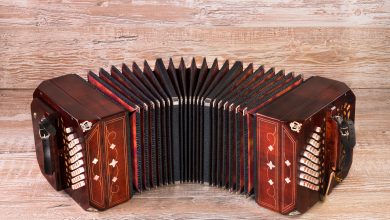The Bandoneon

The Bandoneon is a type of concertina popular in Argentina and Uruguay. It is an essential instrument in most tango groups beginning with the traditional orquesta típica of the 1910s onwards. The bandoneon, like other members of the concertina family, is held between both hands, and by pulling and pushing actions force air through bellows and then routing air through particular reeds by pressing the instrument’s buttons. Bandoneons have a different sound than accordions, because bandoneons do not usually have register switches that are normal on accordions. The tone of the bandoneon can be changed a great deal using varied bellows pressure and overblowing, thus creating potential for expressive playing and diverse sounds.
History
The Bandoneon, named by the German instrument dealer Heinrich Band (1821–1860), was originally meant to be an instrument for religious and popular music of the time, in contrast to its predecessor, German concertina (Konzertina), which had mainly been used in folk music. Around 1870, German and Italian emigrants and sailors brought the bandoneon to Argentina, where it was adopted into tango music.
By the 20th century bandoneons were being produced specifically for the Argentine and Uruguayan markets, with 25,000 shipping to Argentina in 1930 alone. However, declining popularity and the disruption of German manufacturing in World War II led to an end of bandoneon mass-production.
Original bandoneons can be seen in a number of German museums, such as the Preuss family’s Bandoneon Museum in Lichtenberg and the Steinhart family’s collection in Kirchzarten, Freiburg.
Historically, bandoneons were produced primarily in Germany and never in Argentina itself, despite their popularity there. As a result, vintage bandoneons became rare and expensive (costing around US$ 4,000), limiting the opportunities for new bandeonists. In 2014, the National University of Lanús announced a plan to develop an affordable Argentine-made bandoneon, which it hoped to market for much less than the cost of imported vintage instruments.
Technique
The left-hand buttons play bass notes, The right-hand buttons play higher-pitched notes. Each button plays a different note depending on whether the bellows are pulled open or pushed closed.
As with other members of the concertina family, the bandoneon is held between both hands, and pulling and pushing actions force air through bellows and then through particular reeds as selected by pressing the instrument’s buttons. As with other concertinas, the button action is in parallel to the motion of the bellows, and not perpendicular to it as with an accordion.
Unlike what happens with a piano accordion, but in similar fashion to a melodeon or Anglo concertina, a given bandoneon button produces different notes on the push and the pull (bisonoric). This means that each keyboard actually has two layouts: one for opening notes, and one for closing notes. Since the right and left hand layouts are also different, a musician must learn four different keyboard layouts to play the instrument.
These keyboard layouts are not structured to make it easy to play scale passages of single notes: they were originally laid out to facilitate playing chords, for supporting singers of religious music in small churches with no organ or harmonium, or for clergy requiring a portable instrument.
Unisonoric
While the standard bandoneon is bisonoric (different note on push and pull), some bandoneon variants are monosonoric, or unisonoric (same note on push and pull). These include the Ernst Kusserow and Charles Peguri systems, both introduced around 1925.
Famous Bandoneon Players
The Argentinian bandleader, composer, arranger, and tango performer Aníbal Troilo was a leading 20th-century bandoneon player. The bandoneon player and composer Ástor Piazzolla played and arranged in Troilo’s orchestra from 1939 to 1944. Piazzolla’s “Fugata” from 1969 showcases the bandoneon, which plays the initial fugue subject on the first statement, then moves on to the outright tango after the introduction. With his solos and accompaniment on the bandoneon, Piazzolla combined a musical composition much derived from classical music (which he had studied intensively in his formative years) with traditional instrumental tango, to form nuevo tango, his new interpretation of the tango genre.



